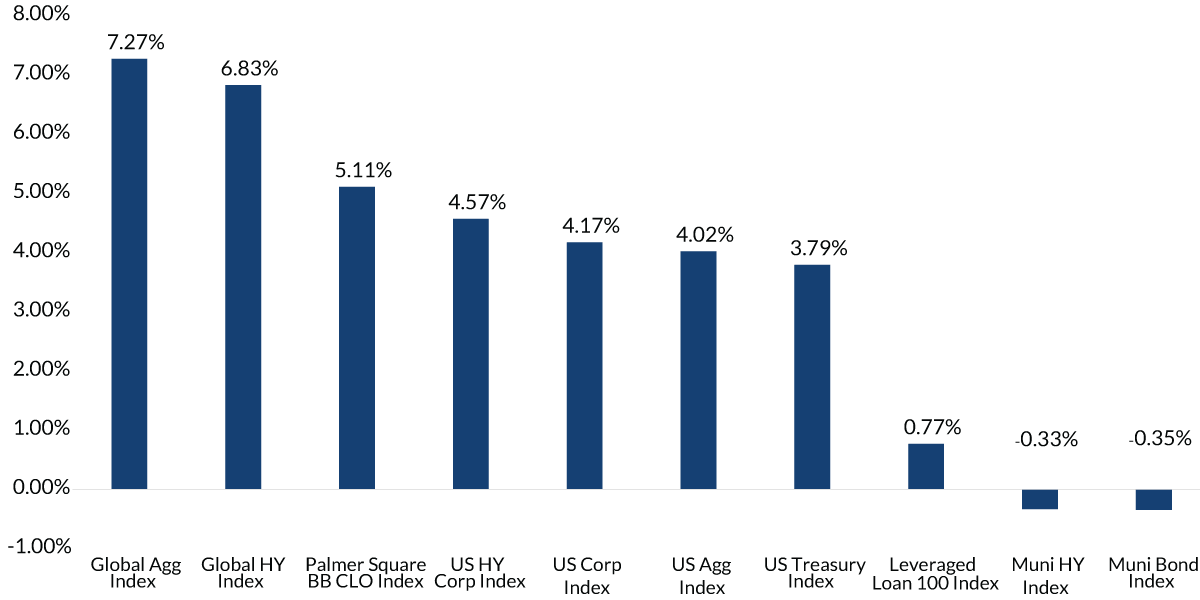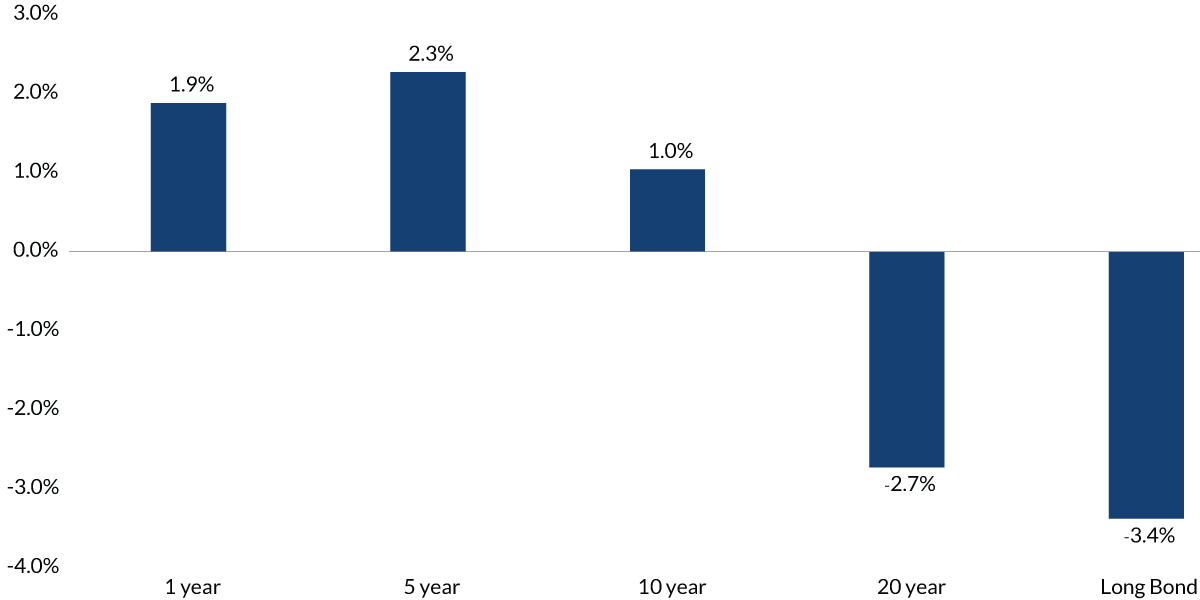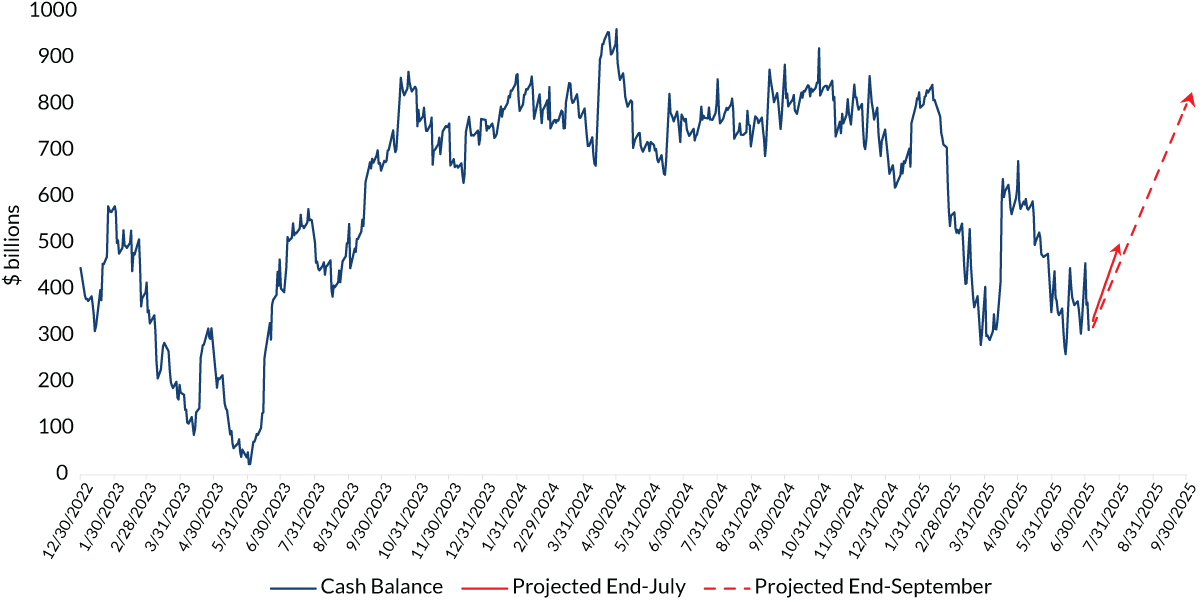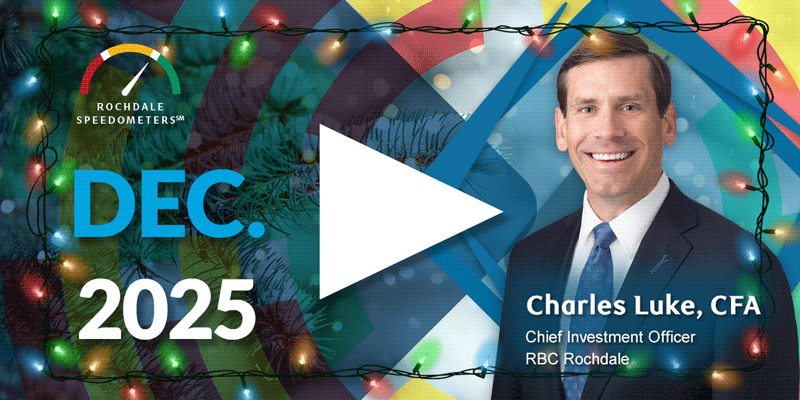-
Fixed Income Perspectives
Half-Time Report Card
July 2025
- Filename
- Fixed Income Perspectives July 2025.pdf
- Format
- application/pdf
TRANSCRIPT
During the first half of the year, bond markets went through elevated volatility, a shifting tariff policy, geopolitical events and federal fiscal uncertainty, which led to sharp moves in yields and valuations. But as we entered the third quarter, the interest rate environment is more stable.
Global Fixed Income Asset Class Year-to-Date Total Returns

Source: Morningstar Leveraged Loan 100 Index, Bloomberg US Corporate High Yield Index, ICE BofA Diversified High Yield EM Corporate Plus Index, Palmer Square BB CLO Index, Bloomberg Municipal Bond Index, Bloomberg US Treasury Index, Bloomberg High Yield Municipal Bond Index and Bloomberg US Corporate Investment Grade Index, Bloomberg Global Aggregate Index, and Bloomberg Global High Yield Index as of 6/30/2025.
Information is subject to change and is not a guarantee of future results.
Chart 1, 0:31– From a return perspective, it has already been a good year for major fixed income markets, which have delivered positive total return year to date. The one exception remains U.S. municipal bonds, which are still moving through the aftermath of trade policy and some unease around the administration’s view of the tax exemption.
Outside of the muni market, performance was supported by attractive yields, durable credit quality and periodic demand for safe haven assets. The top-performing fixed income segment has been global bonds, as a weakening in the U.S. dollar helped boost performance.
Both U.S. domestic investment-grade and high-yield bonds have also rewarded investors with mid-single-digit returns. Turning back to U.S. municipal bonds, as I mentioned, this area of the fixed income market has lagged its peers this year. Municipals have underperformed due to a combination of trade policy risk, the potential loss of the tax exemption and certain technical events.
While the weakness shows up in the top-line numbers, the repricing did not impact the market evenly.
Municipal Bond Maturity Spot Point Total Returns

Source: Bloomberg Municipal Bond Index as of 6/30/2025.
Past performance is not an indication of future returns.
Chart 2, 1:36– To illustrate this, when we observe the performance of specific maturities inside of 15 years, munis have generated positive total returns this year, which contrasts with longer maturities that have been slower to recover from the rate volatility earlier in the year. But we think there are several positive catalysts.
The recently signed reconciliation bill left the muni exemption intact, a risk that dampened demand earlier in the year but is now likely to increase demand in the second half. Additionally, valuations are currently attractive. Long-term municipal yields are becoming more attractive as longer-term rates start to reflect the potential impact of tariffs and government policy. We believe this will improve the advantage of owning municipal bonds versus comparable U.S. treasury securities for high-tax investors.
Regarding U.S. treasuries, the debt limit was raised by $5 trillion in the One Big Beautiful Bill. This now allows investors to refocus their attention away from the debt ceiling and toward anticipated treasury supply needed to replenish low cash balances at the U.S. Treasury.
U.S. Treasury Cash Balances Expected to Increase Near-Term

Source: Bloomberg USCBFDRA Index as of 7/9/2025; projections based on data provided by the U.S. Treasury Department.
Information is subject to change and is not a guarantee of future results.
Chart 3, 2:44– As we can see from this chart, current cash of about $300 billion is projected to reach $500 billion by month end. Despite this uptick in supply, we anticipate investor demand to remain healthy as yields remain attractive versus other short-term market alternatives.
So where does this leave us as we enter the back half of 2025? First, bond markets have been surprisingly resilient despite higher levels of uncertainty and volatility. For investment-grade municipal and corporate bond investors, yields remain compelling and credit conditions favorable.
Within the high-yield markets, income opportunities are attractive. However, tight spreads argue for caution, making security, selection and diversification important. While trends are encouraging, we continue monitoring market risks for signals that trade and other policies will impact inflation and economic growth. We expect this to play out in the coming months and maintain our outlook for one to two rate cuts by year end in line with the market and the FOMC. CNR also forecasts the U.S. 10-year treasury to remain at fair value within the range of 4-4.5%.
Important Information
The views expressed represent the opinions of City National Rochdale, LLC (CNR) which are subject to change and are not intended as a forecast or guarantee of future results. Stated information is provided for informational purposes only, and should not be perceived as personalized investment, financial, legal or tax advice or a recommendation for any security. It is derived from proprietary and non-proprietary sources which have not been independently verified for accuracy or completeness. While CNR believes the information to be accurate and reliable, we do not claim or have responsibility for its completeness, accuracy, or reliability. Actual results, performance or events may differ materially from those expressed or implied in such statements.
All investing is subject to risk, including the possible loss of the money you invest. As with any investment strategy, there is no guarantee that investment objectives will be met, and investors may lose money. Diversification does not ensure a profit or protect against a loss in a declining market. Past performance is no guarantee of future performance.
City National Rochdale, LLC is an SEC-registered investment adviser and wholly-owned subsidiary of City National Bank. Registration as an investment adviser does not imply any level of skill or expertise. City National Bank is a subsidiary of the Royal Bank of Canada.
Fixed Income investing strategies & products. There are inherent risks with fixed income investing. These risks include, but are not limited to, interest rate, call, credit, market, inflation, government policy, liquidity or junk bond risks. When interest rates rise, bond prices fall. This risk is heightened with investments in longer-duration fixed income securities and during periods when prevailing interest rates are low or negative.
Index Definitions:
Bloomberg U.S. Treasury Index: includes all publicly issued, U.S. Treasury securities that are rated investment grade, and have $250 million or more of outstanding face value.
Bloomberg 1-3 Month U.S. Treasury Bill/T-Bill Index (the "Index") is designed to measure the performance of public obligations of the U.S. Treasury that have a remaining maturity of greater than or equal to 1 month and less than 3 months.
Bloomberg U.S. Intermediate Corporate Bond Index measures the performance of U.S. corporate bonds with a maturity of 1–10 years. It's part of the Bloomberg U.S. Corporate Index.
The Bloomberg Municipal Bond: Muni Inter-Short (1-10) Index is a measure of the US municipal tax-exempt investment grade bond market. It includes general obligation and revenue bonds, which both can be pre-refunded years later and get reclassified as such. The effective maturity of the bonds in the index must be greater than or equal to 1 years but less than 10 years.
Bloomberg U.S. Municipal High-Yield Index: covers the U.S.-dollar denominated, non-investment grade, fixed-rate, municipal bond market and includes securities with ratings by Moody’s, Fitch and S&P of Ba1/BB+/BB+ or below.
The Bloomberg US Corporate High Yield Index measures the performance of non-investment grade, US dollar-denominated, fixed-rate, taxable corporate bonds.
ICE BofA Diversified High Yield US Emerging Markets Corporate Plus Index tracks the performance of US dollar denominated below investment grade emerging markets non-sovereign debt publicly issued in the major domestic and Eurobond markets.
The Palmer Square CLO Debt Index (“CLO Debt Index”) (ticker: CLODI) is a rules-based observable pricing and total return index for collateralized loan obligation (“CLO”) debt for sale in the United States, original rated A, BBB, or BB or equivalent.
US Corporate Short 1-5 refers to short-term US corporate bonds with 1–5 years remaining until maturity. These bonds are part of the investment-grade corporate bond market, which is dominated by financial services issuers.
Municipal Short 1-5 refers to a collection of municipal bonds that mature between one and five years. These bonds are a type of debt obligation that pay interest that is exempt from federal income tax.
U.S. Corporate Intermediate 1-10 refers to investment-grade corporate bonds that mature between one and ten years. These bonds are denominated in U.S. dollars and are taxable.
Municipal Short/Intermediate 1-10 is a term used to describe a group of US tax-exempt municipal bonds that have a maturity date between one and ten years. These bonds can be used in a variety of investment strategies, including bond ladders and managed accounts.
© 2025 City National Rochdale, LLC. All rights reserved.
Stay Informed.
Get our Insights delivered straight to your inbox.
Check out previous perspectives:
Put our insights to work for you.
If you have a client with more than $1 million in investable assets and want to find out about the benefits of our intelligently personalized portfolio management, speak with an investment consultant near you today.
If you’re a high-net-worth client who's interested in adding an experienced investment manager to your financial team, learn more about working with us here.



